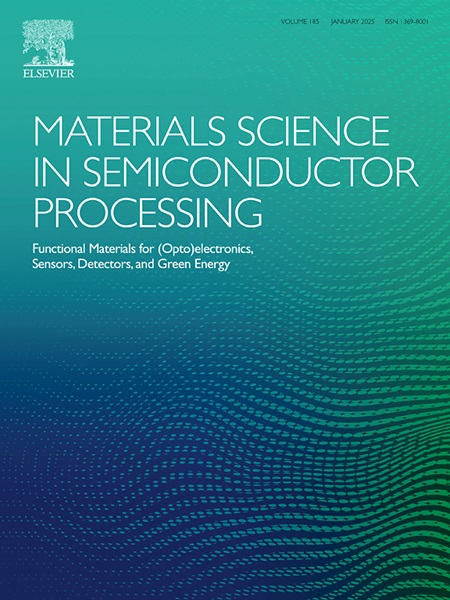Nitrogen doping of polycrystalline, LPCVD 3C-SiC thin films using alternating supply deposition
IF 4.2
3区 工程技术
Q2 ENGINEERING, ELECTRICAL & ELECTRONIC
引用次数: 0
Abstract
In this paper, we demonstrate the implementation of a doping scheme for 3C-SiC thin films using the alternating supply deposition (ASD) technique in a low-pressure chemical vapor deposition (LPCVD) system. The moment of introduction of the dopant is critical and resulted in different thin film resistivities. By synthesizing 3C-SiC thin films with the most promising dopant scheme and increasing ammonia (NH3) flow rates we provide insight of the capabilities of ASD doping. The electrical properties were characterized using the circular transfer length method (CTLM). Promising values for the specific contact resistance around 3·10−6 Ω cm2 were measured and resistivities of ρ = 0.02 Ω cm, which is comparable to state-of-the-art thin film resistivities for polycrystalline 3C-SiC. The temperature dependence of undoped and highly doped thin films are compared from room temperature to 300 °C. For both cases a negative temperature coefficient was determined, which is explained by the effect of incomplete ionization of the dopant. Lowest resistivities of 0.014 Ω cm were measured at 300 °C. Chemical analysis demonstrates for elevated NH3 flow rates a change from highly <111> oriented poly 3C-SiC thin films to amorphous and highly insulating SiCN thin films of only 25 % of the maximum measured thickness. This can be explained by the competition of C and N atoms for Si bonds, which is dominated by nitrogen atoms at higher NH3 flow rates.
用交变电源沉积法制备多晶、LPCVD 3C-SiC薄膜
在本文中,我们展示了在低压化学气相沉积(LPCVD)系统中使用交变电源沉积(ASD)技术对3C-SiC薄膜的掺杂方案的实现。掺杂剂的引入时刻是至关重要的,并导致不同的薄膜电阻率。通过使用最有前途的掺杂方案合成3C-SiC薄膜,并增加氨(NH3)流动速率,我们提供了ASD掺杂能力的见解。利用圆传递长度法(CTLM)对其电性能进行了表征。测量到的比接触电阻值约为3·10−6 Ω cm2,电阻率为ρ = 0.02 Ω cm,与最先进的多晶3C-SiC薄膜电阻率相当。从室温到300℃,比较了未掺杂和高掺杂薄膜的温度依赖性。对于这两种情况,确定了负温度系数,这是由掺杂剂不完全电离的影响来解释的。在300℃时测得最低电阻率为0.014 Ω cm。化学分析表明,NH3流量的升高与高浓度NH3流量的变化。定向聚3C-SiC薄膜到非晶和高度绝缘的SiCN薄膜,其厚度仅为最大测量厚度的25%。这可以解释为C和N原子对Si键的竞争,在较高的NH3流速下,氮原子占主导地位。
本文章由计算机程序翻译,如有差异,请以英文原文为准。
求助全文
约1分钟内获得全文
求助全文
来源期刊

Materials Science in Semiconductor Processing
工程技术-材料科学:综合
CiteScore
8.00
自引率
4.90%
发文量
780
审稿时长
42 days
期刊介绍:
Materials Science in Semiconductor Processing provides a unique forum for the discussion of novel processing, applications and theoretical studies of functional materials and devices for (opto)electronics, sensors, detectors, biotechnology and green energy.
Each issue will aim to provide a snapshot of current insights, new achievements, breakthroughs and future trends in such diverse fields as microelectronics, energy conversion and storage, communications, biotechnology, (photo)catalysis, nano- and thin-film technology, hybrid and composite materials, chemical processing, vapor-phase deposition, device fabrication, and modelling, which are the backbone of advanced semiconductor processing and applications.
Coverage will include: advanced lithography for submicron devices; etching and related topics; ion implantation; damage evolution and related issues; plasma and thermal CVD; rapid thermal processing; advanced metallization and interconnect schemes; thin dielectric layers, oxidation; sol-gel processing; chemical bath and (electro)chemical deposition; compound semiconductor processing; new non-oxide materials and their applications; (macro)molecular and hybrid materials; molecular dynamics, ab-initio methods, Monte Carlo, etc.; new materials and processes for discrete and integrated circuits; magnetic materials and spintronics; heterostructures and quantum devices; engineering of the electrical and optical properties of semiconductors; crystal growth mechanisms; reliability, defect density, intrinsic impurities and defects.
 求助内容:
求助内容: 应助结果提醒方式:
应助结果提醒方式:


